Saw Blade Terminology
The following are common terms associated with Saw Blades. Please use these explanations to assist you in choosing the correct Saw Blade for your application.
1. TOOTH CONFIGURATIONS


FLAT TOP
(FT)
Used on saw blades for cutting soft and hardwood along the grain (ripping).


ALTERNATE TOP BEVEL
(ATB)
Alternate right top bevel and left top bevel.
Used on saw blades for general purpose and crosscutting natural wood & veneered plywood.


ALTERNATE TOP BEVEL MODIFIED
(H-ATB)
Higher top bevel grind and longer tooth than our standard alternate top bevel. Used on 'MB' and 'MSB' series blades and specifically designed for cutting melamine chip-free on table saws without the aid of scoring units.
Also used on dado sets, only every 6th tooth is flat ground.


COMBINATION TOOTH
(4 & 1)
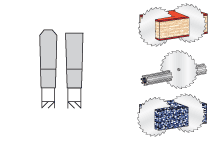

TRIPLE CHIP
(TCG)
Alternate flat rager tooth and higher trapeze tooth divides the chips to achieve cuts in hard materials, MDF, OSB and plastics. Also used on blades for cutting non-ferrous materials.


CALIFORNIA TRIPLE CHIP
(TCG)
For use in miter saws in picture frame shops, window door manufacturers, or anywhere that miter machines are used.
Produces burr-free cuts in non-ferrous materials as well as splinter-free cuts in wood and wood-based products.


CONE FORM (CONICAL)
Used in conical tooth scoring blades.


HOLLOW GROUND
(HG)
Hollow face grind is used for cutting melamine and other difficult to machine materials. Generally used on vertical panel saws (Striebig, etc.).
2. TOOTH ANGLES


HOOK (RAKE) ANGLE
6° - 22°
Soft materials or rip blades require an angle of about 18° to 22°, hard materials about 6°.
Saw blades for cutting aluminum and melamine have a negative hook angle.


TOP CLEARANCE ANGLE
12 ° - 15 °
This angle changes according to the hardness of material; 12° for hard and 15° for softer materials.
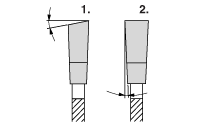

1. TOP BEVEL ANGLE
6° - 22°
2. RADIAL SIDE ANGLE
1 ° - 2°
Normally 10°, enabling gradual penetration into material. Allows clearance along the sides of the tooth.
3. GENERAL
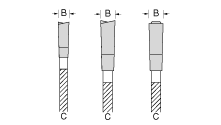

KERF ('B')
PLATE ('C')
Refers to the largest width of the saw tooth and is represented in decimals and/or millimeters.
Refers to the thickness of the steel saw body, onto which the carbide teeth are brazed. This dimension is represented in decimals and/or millimeters.
NOTE: Most industrial series saw plates are laser cut.
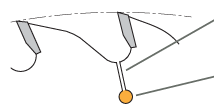

EXPANSION SLOTS
COPPER PLUGS
Allows the saw body to expand and contract under load and head to prevent twisting or warpage.
Reduces the turbulent noise created by the saw blade while it is being operated.
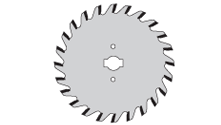

BORE, PIN-HOLES, KEYWAYS
Refers to the diameter of the arbor hole, pin-holes, keyways, etc. and is represented in fractions or millimeters.
P.H. denotes pin-hole configuration, if applicable.
Example: 2/10/60 = 2 @ 10mm dia. on a 60mm circle.


